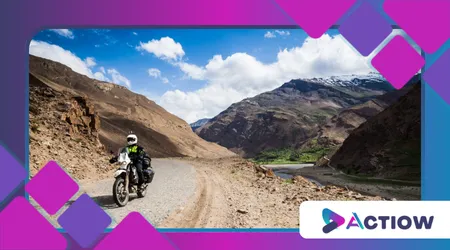How to Safely Ride a Motorcycle on Gravel Roads
Anúncios
Safely Ride a Motorcycle on Gravel Roads!

Gravel roads present a unique challenge for motorcyclists, blending unpredictability with adventure.
Unlike smooth asphalt, gravel demands respect, precision, and a keen understanding of your bike’s behavior.
Anúncios
Mastering this terrain not only enhances your riding skills but also unlocks remote routes often inaccessible to casual travelers.
This guide dives deep into the art and science of safely riding a motorcycle on gravel roads, offering practical strategies, original insights, and actionable advice to ensure confidence and control.
Whether you’re a seasoned rider or venturing onto gravel for the first time, understanding the nuances of loose surfaces can transform uncertainty into exhilaration.
So, how do you navigate these unpredictable paths without compromising safety?
Let’s explore the essential techniques, preparation, and mindset needed to conquer gravel roads with finesse.
Safely Ride a Motorcycle on Gravel Roads: Table of Contents
- Understanding Gravel Roads: The Terrain and Its Challenges
- Preparing Your Motorcycle for Gravel Riding
- Mastering Riding Techniques for Loose Surfaces
- Safety Gear and Personal Preparation
- Common Mistakes and How to Avoid Them
- Frequently Asked Questions
++ The Hidden Message Behind Rolls-Royce Hood Ornaments
1. Understanding Gravel Roads: The Terrain and Its Challenges

Gravel roads are a mosaic of loose stones, dirt, and uneven surfaces, each presenting distinct obstacles.
Unlike paved roads, gravel lacks uniformity, creating a dynamic environment where traction fluctuates.
The surface can shift from tightly packed stones to deep, loose piles within meters, demanding constant vigilance.
For instance, a rider named Ana, exploring the backroads of Patagonia, encountered a sudden patch of deep gravel that nearly threw her off balance.
By slowing her pace and adjusting her posture, she regained control, illustrating the importance of anticipating surface changes.
++ How to Prep Your Motorcycle for a Long-Distance Adventure
Moreover, gravel roads often hide hazards like ruts, washboards, or hidden rocks beneath a deceptively smooth layer.
Weather plays a significant role too—rain can turn gravel into a slick, muddy trap, while dry conditions may create dust clouds that obscure vision.
According to the Motorcycle Safety Foundation, approximately 15% of motorcycle crashes on non-paved surfaces occur due to loss of traction on gravel or dirt.
This statistic underscores the need for riders to understand the terrain’s behavior before tackling it.
Think of riding on gravel like dancing with a partner who keeps changing the rhythm. You must stay alert, adapt quickly, and maintain balance to avoid missteps.
By studying the road’s texture and anticipating its shifts, riders can transform gravel from a foe into a thrilling dancefloor.
Why risk a fall when preparation can keep you upright?
2. Preparing Your Motorcycle for Gravel Riding
Before hitting gravel, your motorcycle needs to be as ready as you are.
First, consider your tires. Knobby or dual-sport tires with deeper treads provide better grip on loose surfaces compared to street-oriented tires.
For example, when João, a Brazilian rider, swapped his road tires for dual-sport ones before a trip through the Serra da Canastra, he noticed a dramatic improvement in stability over loose gravel.
++ Software-Defined Vehicles: The New Era of Automotive Software
Ensuring proper tire pressure is equally critical—slightly lower pressure (around 25-30 psi, depending on the bike) increases the contact patch, enhancing traction.
Additionally, adjust your suspension to handle gravel’s uneven nature.
Softer settings allow the bike to absorb bumps and maintain contact with the ground, reducing the risk of skidding.
Check your chain tension and brakes too; gravel can accelerate wear, and a loose chain or worn pads could spell trouble.
A quick pre-ride inspection, including fluid levels and bolt tightness, can prevent mechanical failures miles from civilization.
| Preparation Checklist | Why It Matters | Recommended Action |
|---|---|---|
| Tire Type and Pressure | Ensures traction | Use dual-sport tires; set pressure to 25-30 psi |
| Suspension Settings | Absorbs uneven terrain | Soften suspension for better ground contact |
| Chain and Brake Check | Prevents mechanical issues | Inspect and adjust chain; ensure brake pads are fresh |
By equipping your bike for gravel, you’re not just preparing for a ride—you’re building a reliable partner for the journey.
A well-prepped motorcycle responds predictably, letting you focus on the road rather than worrying about breakdowns.
3. Mastering Riding Techniques for Loose Surfaces
Riding on gravel demands a shift in technique, prioritizing balance and control over speed.
First, maintain a relaxed posture. Grip the handlebars lightly, keep your elbows bent, and let your body move with the bike.
This flexibility allows you to absorb shocks and maintain stability.
For instance, during a ride through the Australian Outback, Sarah avoided a wipeout by staying loose when her bike fishtailed on loose gravel, steering gently to regain control.
Furthermore, weight distribution is key. Shift your body slightly back to keep the front wheel light, reducing the chance of it digging into deep gravel.
When cornering, lean the bike more than your body, using your legs to counterbalance.
This technique, often called “counter-leaning,” prevents the front wheel from washing out.
Braking requires finesse too—use both brakes gently, favoring the rear to avoid locking the front wheel, which can lead to a skid.
Finally, maintain a steady throttle.
Sudden acceleration can cause the rear wheel to spin out, while abrupt deceleration may destabilize the bike.
Practice in a controlled environment, like an empty gravel lot, to build confidence.
By mastering these techniques, you’ll navigate gravel with the precision of a tightrope walker, balancing effort and control seamlessly.
| Riding Technique | Purpose | How to Execute |
|---|---|---|
| Relaxed Posture | Maintains balance | Keep elbows bent, grip lightly |
| Weight Distribution | Prevents wheel dig-in | Shift weight back, keep front wheel light |
| Steady Throttle | Avoids wheel spin | Apply smooth, consistent throttle |
4. Safety Gear and Personal Preparation
Safety gear is non-negotiable on gravel roads, where falls are more likely.
A full-face helmet with a visor protects against flying stones and dust, while armored jackets and pants absorb impact.
Boots with ankle support and gloves with reinforced palms are essential for maintaining control and minimizing injury.
Consider a rider like Miguel, who avoided serious injury during a low-speed gravel slide in the Andes thanks to his padded gear—his elbow pads took the brunt of the impact.
Beyond gear, mental preparation is crucial.
Gravel riding tests your focus and patience, so approach it with a clear mind. Visualize potential hazards, like sudden ruts or loose patches, and plan your responses.
Hydration and rest are equally important; fatigue can dull your reflexes, increasing the risk of errors.
Before a long gravel ride, practice mindfulness techniques, like deep breathing, to stay calm under pressure.
| Safety Gear | Protection Offered | Recommendation |
|---|---|---|
| Full-Face Helmet | Head and face protection | Choose DOT or ECE certified helmets |
| Armored Jacket | Upper body protection | Select jackets with CE-rated armor |
| Riding Boots | Ankle and foot support | Opt for boots with oil-resistant soles |
Investing in quality gear and mental readiness isn’t just about safety—it’s about empowering yourself to ride with confidence.
After all, why gamble with your well-being when the right preparation can make all the difference?
5. Common Mistakes and How to Avoid Them
One frequent mistake is riding too fast for the conditions.
Gravel’s unpredictability punishes overconfidence; a sudden patch of loose stones can destabilize even the most skilled rider.
To avoid this, scan the road ahead and adjust your speed proactively.
Slowing down before a tricky section gives you time to react, unlike speeding through and hoping for the best.
Another error is improper braking. Locking the front wheel by braking too hard can cause a skid, especially on loose surfaces.
Instead, apply brakes gradually, using the rear brake more heavily to maintain control.
Additionally, many riders tense up when they hit gravel, gripping the handlebars tightly.
This rigidity reduces your ability to steer smoothly. Practice relaxing your grip in low-stakes environments to build muscle memory.
Lastly, neglecting bike maintenance can lead to disaster.
A loose chain or underinflated tires can exacerbate gravel’s challenges, turning a manageable ride into a dangerous one.
Regular checks and adjustments, as outlined earlier, prevent these issues. By sidestepping these pitfalls, you’ll ride with greater assurance and fewer surprises.
| Common Mistake | Consequence | How to Avoid |
|---|---|---|
| Riding Too Fast | Loss of control | Scan ahead, reduce speed |
| Improper Braking | Wheel lock-up | Use rear brake primarily, apply gently |
| Tensing Up | Reduced steering control | Practice relaxed posture |
6. Frequently Asked Questions: Safely Ride a Motorcycle on Gravel Roads
| Question | Answer |
|---|---|
| Can I ride gravel with street tires? | While possible, street tires offer less grip. Dual-sport tires are recommended for better traction and control. |
| How do I recover from a skid? | Stay calm, reduce throttle, and steer gently in the direction of the skid to regain traction. |
| Is gravel riding safe for beginners? | With proper preparation and practice, beginners can ride gravel safely. Start on easy trails and build skills gradually. |
| How does weather affect gravel riding? | Rain creates slippery conditions, while dry weather can reduce visibility with dust. Adjust speed and gear accordingly. |
Safely Ride a Motorcycle on Gravel Roads: Conclusion
Riding a motorcycle on gravel roads is a thrilling yet demanding endeavor that rewards preparation, technique, and respect for the terrain.
By understanding gravel’s challenges, equipping your bike, mastering riding techniques, prioritizing safety gear, and avoiding common mistakes, you can navigate these unpredictable paths with confidence.
The journey may test your skills, but with the right approach, it’s an opportunity to grow as a rider and explore the world’s wilder routes.
For further reading, check these resources:
